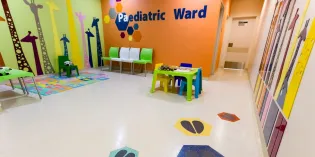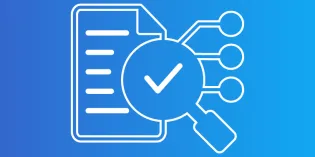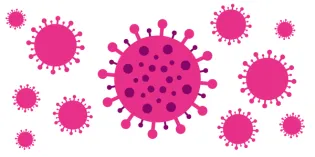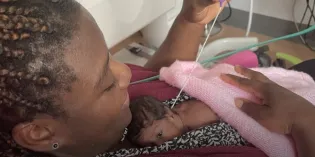Introduction
In March 2020, it became clear that the NHS was facing an enormous challenge in responding to the novel coronavirus pandemic. This included child health services who had to respond rapidly with no precedence or rulebook.
Whilst children and young people rarely have severe illness caused by the virus, there were concerns about the unintended consequences of the pandemic and lockdown measures. Plans to redeploy paediatric staff and use paediatric inpatient and clinic space for adult COVID-19 patients would affect children’s services. There were also concerns about parents and carers delaying seeking access to care for children due to fear of exposure to the virus in clinical settings and not being able to stay with their child.
We knew there would be large variation in how services were affected, depending on local incidence rates and the systems they were working in. However, there was a lack of data about how services were coping, what types of pressures they were under, and how things changed over time. This information was needed to help services assess their situation, plan next steps, and as evidence to decision makers about the challenges child health services were facing.
We launched this project in April 2020 and collected data for twelve weeks, with the aim of tracking patterns and trends in child health services. An online platform was built where data could be submitted and viewed in real time by registered users. The platform remains open for all RCPCH members (or those with a legitimate interest) to view the findings, broken down by week and NHS region. We also displayed publicly available findings on the RCPCH website on a weekly basis.
During data collection, the information was passed on to various decision makers at local and national level as well as other stakeholders. We plan to continue to use the findings to supporting planning local services ahead of winter and as an influencing tool with the governments across the UK.
Main findings
- Up to 10% of all paediatric staff were not available to work, e.g. due to shielding. A further ~13% were working in different ways, e.g. remote working.
- Up to a fifth of tier 1 paediatric staff were redeployed to adult services. Only small numbers of more senior staff were redeployed.
- Up to 46% of community trainees were redeployed to acute paediatric care, and by end of data collection in July, 10% were still not working in community settings. Up to 14% of community career grade doctors were also redeployed. This is worrying because of the importance of community services for vulnerable children, and the backlog of work such as child protection medicals.
- Availability of PPE for paediatric staff was between 95 and 100%.
- Availability of testing for staff rose from 80% in April to 100% by July.
- Paediatric inpatient space lost to adult services was small but important (1-6%), with reported issues getting space back.
- Activity across all types of paediatric care was decreased or unchanged compared to the same week last year. However, many respondents were worried about the children they weren’t seeing.
- A small but important number of late presentations were reported, the top being delayed presentation of diabetic conditions, safeguarding concerns, mental health issues, and sepsis.
- Reports of decreased activity across different areas of child services were not followed by recovery of activity within the data collection period. This suggests a high backlog of cases.
Results
How were staff affected?
Redeployment to adult services
At the start of data collection, in April 2020, over a fifth (22%) of those normally on the Tier 1 acute paediatric rota were redeployed to adult services. By the end of data collection in July 2020, 2% of Tier 1 staff had not yet returned. More senior staff were less likely to be moved to adult services, with only up to 3% of Tier 2 and up to 2% of Tier 3 staff being redeployed.
Figure 1. Average % response to “What proportion of Tier 1, 2, and 3 acute paediatric medical staff have been moved to adult services?"
Redeployment to other services within paediatrics
As well as redeployment to adult services to support the coronavirus response, paediatric staff were also redeployed within paediatrics, often moving to the acute service, possibly to backfill the loss of Tier 1 staff as detailed above.
A high proportion of community child health staff were redeployed within paediatrics. Up to 46% of community trainees, and up to 14% of community career grade doctors.
Figure 2. Average % response to “What proportion of community career grade staff have been redeployed to another area of paediatrics?” and “What proportion of community trainees have been redeployed to another area of paediatrics?”
Furthermore, 7 to 11% of sub-specialty paediatric staff were moved to the acute rota, and 9% still had not returned by the end of data collection in July 2020.
Figure 3. Average % response to “What proportion of sub-specialty paediatric staff have moved to the acute rota full time?”
Availability to work
Up to 10% of all paediatric medical staff were not available to work between April and June.
Figure 4. Average % response to “What proportion of all paediatric medical staff are not available to work (i.e. sick or self-isolating?)” 1
Following changes to shielding advice, and to gather more in-depth data, we retired the original question on 5 June about availability of staff to work and added two new questions.
This revealed that 4 to 5% of staff were not available to do any paediatric work due to redeployment or illness in June and July. A further 10 to 12% of paediatric staff were working in new ways, e.g. due to shielding or self-isolating. For example, helping with NHS 111 calls.
This shows that whilst staff may be returning from redeployment in the summer of 2020, there is still a reduction in the workforce availability from baseline.
Figure 5. Average % response to “What proportion of paediatric medical staff are not available to do any paediatric work (redeployment, illness, etc.)?” and “What proportion of paediatric medical staff are working in new ways (shielding or self-isolating)?”2
Availability of PPE and COVID-19 testing for staff
In April, there were worrying reports of a lack of availability of Personal Protective Equipment (PPE) and COVID-19 testing for NHS staff.
We found that only 82% of paediatric staff in the UK had access to sufficient COVID-19 testing on 17 April. Fortunately, this rose to 100% by 3 July.
There was good availability of PPE in paediatric services. 95% of paediatric staff in the UK had sufficient PPE that fulfilled the government safety guidance in April, and this rose to 100% by July.
Figure 6. Average % response to “What proportion of the time in the past week have you had enough Personal Protective Equipment (that safely fulfil the UK government guidance) for paediatric staff in your organisation?” and “What proportion of the time in the past week has enough COVID-19 testing been available for paediatric staff in your organisation?”
How were services affected?
Inpatient capacity
The loss of paediatric inpatient space was relatively small throughout the data collection period, ranging from 3 to 6%. However, over 3% of paediatric inpatient space was still lost to adult services on 3rd July.
Figure 7. Average % response to “What proportion of paediatric inpatient capacity have you lost to adult services?”
Outpatient services
Loss of outpatient and clinic capacity was not a specific question. However, it was a common theme in the concerns raised by respondents in the free text submissions about concerns for services and areas that are struggling to restore.
Concerns tended to be about catching up on the backlog of cases they have not been able to see, and the long-term harm that may arise from children missing appointments. There were also worries that moving to virtual appointments is not appropriate for all consultations and may result in missing safeguarding cases or other issues. See the Concerns and Barriers to restoring services sections below for further detail.
Innovation
Respondents were asked, “Do you have any examples of innovative practice happening in your service that we can share with others?”
A wide range of emerging innovative practices were reported, and these fell into seven main categories (see figure below). Some of these examples of innovation were written up as a report on QI Central3 .
Figure 8. Count of themes in responses to the question “Do you have any examples of innovative practice happening in your service that we can share with others?”
Concerns
Respondents were asked, “Do you have any concerns about your service, such as impact on patient safety, that you would like to share confidentially with us?”. Most responded that they did not have any serious concerns. Where respondents did report concerns about their service, the most common theme was worries about safeguarding and hidden harm in children, followed by the lack of face-to-face contact, and then delayed presentations of unwell children. Quotes from some of the most common concerns can be seen below.
Following data collection, a panel of expert clinicians reviewed the serious concern submissions to determine whether any should be followed up. Where responses were flagged, we invited the respondent to have a phone call with one of the volunteers to signpost support.
Figure 9. Count of themes in responses to the question “Do you have any concerns about your service, such as impact on patient safety, that you would like to share confidentially with us?”
Safeguarding and hidden harm
The most commonly reported concern was about potential hidden harm to vulnerable children during lockdown. Paediatricians, along with many others, were worried about how lockdown would put the most vulnerable at further risk. Below, the respondent highlights increased reports of online abuse:
Increase safeguarding work from police involving online child sexual abuse and exploitation. Expectation of hidden NAI [Non-Accidental Injury] and CSA [Child Sexual Abuse] safeguarding work.
In this example, the respondent explains how they are aiming to mitigate risks to vulnerable children:
We remain concerned about hidden children and safeguarding risks and mitigating this by school nurses of special schools, making regular phone calls to families and Health visitors doing phone calls etc. for those on CPP and Child in need.
Many people reported that reduced activity caused alarm bells about the children they weren’t seeing, and the likely backlog of cases:
I have concerns that we have had a reduction in children seen for possible physical abuse. I suspect this means that any children are not presenting to services at present.
At a broader level, the respondent below highlights how there is inequality in the impact of isolation policies on families without resources:
Use of 'super green' pathways with 2 week isolation for elective cases is difficult for some families - some concerned about job losses/financial implications. This yet again disadvantages poor families and their children who need surgery. An opening discrepancy between children whose lives starting to normalise and those with long standing health issues who remain shielded so can’t go to school or can’t access essential care such as therapies or surgery and whose conditions are deteriorating.
Lack of face to face contact
Where children were having virtual contact with paediatricians, there were still concerns that safeguarding issues could be missed without face to face contact:
Worried about what we may be missing by not doing face to face contact except where we identify strong reason to do so- e.g. main reason for doctors doing IHA [Initial Health Assessment] for LAC [Looked After Children] is for medical examination-which we are not currently doing.
Telephone consultations in paediatric population could be a safeguarding issue and also missing a diagnosis. Paediatric patients should be seen face to face as usual.
Staff shortages and redeployment
Redeployment and shielding in paediatrics is high, impacting on the workforce available for "front line" service:
Number of vulnerable consultants who have been advised by occupational health can't see suspected/confirmed covid patients impacting ability to maintain consultant rota - currently managing with locums but concern.
We are working hard to mitigate risk. Lots of concern regarding redeployment of nursing and therapy staff from children's service to adult services. Paediatricians have actually been working hard to mitigate this risk. Remaining nurses and therapists requiring lots of support but also doing fantastic work to support families to access medical care.
Staff safety
Overall, availability of PPE was good, but some respondents noted that paediatrics was not prioritised for adequate PPE and there was a lack of understanding about risk:
Lack of appreciation of how paediatric services run impacting on ability to get adequate PPE for staff - not listed as high priority for individual masks for those failing fit testing for standard masks as classified as a "non-covid" or "non-high risk" area - difficult to get services to appreciate we cannot move patients to a covid ward, or to ICU if they require aerosol generating procedure therefore will be both covid positive and high risk procedures at times on the ward.
The wellbeing of staff has also been affected during this period, especially those at greater risk such as Black, Asian and Minority Ethnic (BAME) colleagues.
On going anxiety for staff on frontline, especially BAME. Day to day anxieties regarding covering rota gaps that can arise quickly e.g. COVID symptoms needing self-isolation.
Staff stressed. Especially our BAME colleagues.
Significant increase of stress on junior trainees having to cover additional duties due to urgent care temporarily moved to paediatric unit (to facilitate adult services)- delay in service returning despite Trust plan.
Waiting lists and backlog
Many respondents mentioned their worries about the backlog of cases due to cancelled outpatient, assessment and elective work, such as surgeries:
There are now at least three children in our area who should have had endoscopy performed urgently who have not had this. In addition the number of children waiting for elective but necessary surgery for a variety of procedures is ever increasing.
This may have knock-on impact for children and result in long-term harm:
We are very concerned about our MRI GA [under general anaesthetic] lists which have all been stopped due to anaesthetic capacity, and we have moved to trying to get them done under sedation instead to mitigate the risk which is imperfect.
We are going to face huge waiting lists for initial consultations and further developmental assessment and examination… the impact is that some children will have delayed assessments and there may be some “harm” from not identifying certain conditions e.g. Duchenne muscular dystrophy, rickets, late presentation of CDH [congenital diaphragmatic hernia] etc., which will have a long term impact on the child.
Huge impact on safety of children waiting for outpatient appointments & investigations which have been stood down to support acute adult services.
In community services, already long waiting lists, e.g. for autism diagnoses, have been exacerbated:
We also have long waiting lists (18months) for children waiting for ASD diagnostic assessment reflecting doubling of referrals across [the region] in last 4 years. This waiting time is growing as we are not able to complete diagnostic assessment at present.
Barriers to restoring services
From Friday 12 June, when health services were starting to see a restoration of activity, respondents were asked, “Now that services are starting to return to normal, are you aware of any areas that are struggling to restore (such as Rapid Access Clinics, immunisation, child protection medicals), and if so, what are the reasons?”
By far the most reported issue was that outpatient services and elective admissions were struggling to restore. There were also reports that paediatric space had not been returned from other services, and concerns about maintaining social distancing.
Figure 10. Count of themes in responses to the question ““Now that services are starting to return to normal, are you aware of any areas that are struggling to restore (such as Rapid Access Clinics, immunisation, child protection medicals), and if so, what are the reasons?”
How did children's presentation to services change?
Overall, children’s presentation to most health services dropped during lockdown. This was likely due to government advice about restricting travel and concerns about risk of infection in a clinical context. However, as discussed above, many respondents were worried about unwell and vulnerable children not being able to access care.
Attendances are massively down - where are these troubled young folk?
I believe there needs to be a stronger message going out that children are pretty safe from Covid… parents remain terrified of coming anywhere near a hospital!
Activity levels
Respondents were asked, “In the 7 days up to 08:00 on [date of Friday in the current collection week] has there been a change in any of the following areas of activity due to COVID-19? This is compared to "normal" levels of activity, i.e. the same week in previous years.”
Figure 11. Hospital inpatient activity levels
At the beginning of data collection in April, up to 90% of services reported a decrease in inpatient activity. This fell to 49% by 3rd July, but only 9% reported an increase in inpatient activity compared to the same time last year.
There was greater variation over time in hospital outpatient activity, with less sign of a “recovery” in activity by July. Overall, 45% to 76% of services reported a decrease in outpatient activity.
Figure 12. Hospital outpatient activity levels
Planned admissions activity was lower than usual consistently across the data collection period, with no clear signs of recovery yet. 84% to 65% of services reported decreased planned admissions between April and July.
Figure 13. Planned admission (e.g. investigations) activity levels
Routine statutory work, such as services for children with Special Educational Needs and Disability (SEND), Looked After Children (LAC), and safeguarding peer reviews, was less affected. However, up to 56% of services reported a decrease in routine statutory work in April. By July, 80% of services reported that activity was the same as this time last year. However, note that 4 to 9% of services consistently reported increased statutory work during the data collection period.
Figure 14. Routine statutory work (e.g. SEND, LAC, safeguarding peer review) activity levels.
Most services reported a decrease in urgent care and ED activity; up to 93% at the beginning of data collection. There was a trend towards recovery of urgent care activity, but 52% of services still reported lower than average activity by July.
Figure 15. Urgent care / Emergency Department activity levels
Delayed presentations
Respondents were asked about children who presented later than usual to their Emergency Departments, at risk of harm due to either an acute new condition or an exacerbation of a long-term condition. The average numbers per organisation were low; less than one case per week. But this adds up 230 children at risk of harm due to delayed presentation of an acute new condition, plus 106 children with exacerbation of a long-term condition.
Figure 16. Average response per organisation to “How many children have "presented late" to the Emergency Department at risk of harm related to a) Delay in acute new conditions; b) Exacerbation of long-term conditions”
We asked for further information about late presentation, and respondents gave detail about 200 cases. They reported that the most common cause of late presentation was diabetes ketoacidosis (mentioned 16 times), followed by deliberate self-harm (15), sepsis (13), mental health problems (13), malignancy (13) and other diabetes-related problems (13).
Figure 17. Count of themes in responses to the question “Please add any further comments [about children presenting late to the Emergency Department at risk of harm].”
The free-text comments from clinicians about delayed presentation reveal the severity and complexity of the impact of COVID-19, especially on vulnerable children and families often seen by community services. Comments from clinicians in acute settings demonstrate how cancellation of planned activity, such as surgery, can exacerbate problems. Furthermore, problems in the care pathway (e.g. NHS 111 and GP referrals) can result in delayed presentation and increased harm.
Methodology
Procedure
In the first instance, paediatric clinical leads of all Trusts and Health Boards in the UK were contacted using the RCPCH’s database. The software company East Face built a bespoke online data collection and reporting system. We invited clinical leads to register for a login to the system. Data submission responsibility could also be delegated to colleagues, in which case they were also invited to register.
Respondents were asked to submit data about their service on a weekly basis over twelve weeks, from Friday 17 April to Friday 3 July 2020. Collection remained open until 31 July to allow respondents to submit data retrospectively.
Data were initially collected at the health provider level (i.e. Trust or Health Board) rather than the service level (e.g. hospital) to allow rapid launch. However, some health providers were split into constituent services at the request of leads to allow individual hospitals or community services to respond. At the close of the project, there was a total of 203 organisations listed.
Questions
You can download the full set of questions below. Respondent were asked to submit data about “the 7 days up to 08:00 on [date of Friday in the current collection week]”. Questions were answered as compared to "normal" levels of staffing and capacity, i.e. the same week in previous years. Some questions were changed over the data collection period in response to changing priorities.
Response rate
We had registered users for 68% (139/203) of all the listed paediatric organisations in the UK. However, a smaller proportion submitted data. Response rate per week varied from a 30% to 53%, with a drop in response nearer the end of data collection.
Figure 18. Response rate for all organisations by week
Response rate also varied by region, which should be considered when interpreting the data. For example, we had a poor response rate from London services, which may have been one of the areas most impacted by reconfiguration and redeployment of staff.
Figure 19. Response rate across all weeks by NHSE Region and devolved nation.
Analysis
Quantitative analysis
Where responses were given as a proportion from 0 to 100 (service and capacity questions), average percentages per week were calculated; error margins show Standard Error of Mean (SEM). For activity level questions (response options: increased/decreased/unchanged), proportion overall of each response per week were calculated. For number of delayed presentations, averages per organisation week were calculated; error margins show SEM.
Qualitative analysis
Four open-ended questions were asked:
- Innovation. Do you have any examples of innovative practice happening in your service that we can share with others?
- Data collected from 17 April 2020 to 5 June 2020 (eight weeks).
- Serious concerns. Do you have any concerns about your service, such as impact on patient safety, that you would like to share confidentially with us?
- Delayed presentations. Please add any further comments [about children presenting late to the Emergency Department at risk of harm].
- Restoring services. Now that services are starting to return to normal, are you aware of any areas that are struggling to restore (such as Rapid Access Clinics, immunisation, child protection medicals), and if so, what are the reasons?
- Data collected from 12 June 2020 to 3 July 2020 (four weeks).
For each question, we collated free-text responses from across the weeks surveyed and assigned a theme to each. Some responses had more than one theme, and these were labelled as primary, secondary, etc.
Themes were double coded, first by our team Analyst and second separately by an expert in the field who was not part of the project team. The themes were then aligned between the two coders.
For the delayed presentations free-text, descriptions of cases were coded according to the World Health Organisation’s international statistical classification of diseases, ICD-10.
All quotes from the free-text questions have been fully anonymised. Responses were not included that risked identifying the service or individual.
Contributors
A huge thank you to everyone who submitted data.
Marie Rogers (Workforce Manager), Nawsheen Boodhun (Project Lead), Davide Carzedda (Analyst) and Natascha Banziger (Local Influencing Coordinator) lead the project.
Dr Nicola Jay (Workforce Officer) and Prof Nick Bishop (VP for Research) are the clinical leads.
Emily Arkell (Director for Research and QI) is the senior management sponsor.
Mark Bailey at East Face developed the online platform.
- 1This question was no longer asked after June 5.
- 2These questions were added on 12 June.
- 3www.qicentral.org.uk/news/covid19-qi-frontline-30th-april-2020










